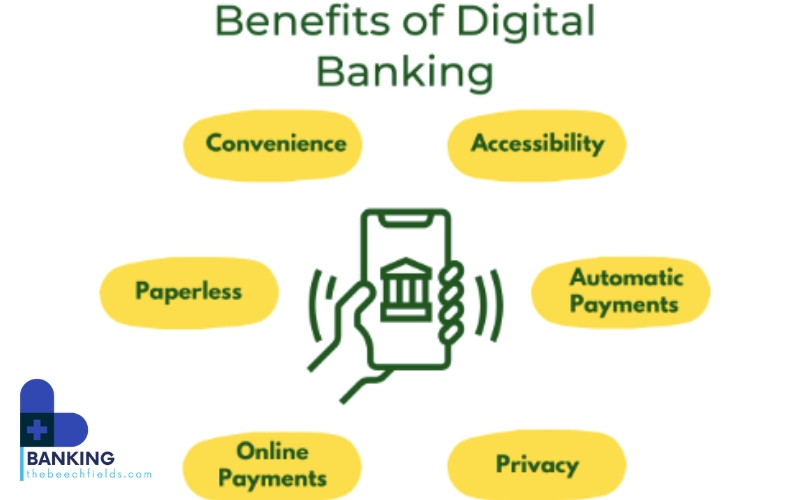Digital banking, one of the prominent trends in the financial industry, is no longer a strange concept to users. With the use of digital banking, customers can easily conduct financial transactions anytime, anywhere without having to go directly to bank branches. The application of digital technology in the banking industry brings many obvious benefits not only to customers but also to financial institutions. This article will analyze in detail the outstanding benefits of using digital banking, from convenience to high security.
1. SAVE TIME
One of the biggest benefits of using digital banking is saving time. Instead of having to go to the bank, wait at the counter to complete procedures, users only need to use the banking application on their phone or computer to complete transactions quickly. With digital banking, you can perform many transactions such as transferring money, paying bills, checking account balances or even applying for credit loans in just a few minutes without having to leave your home.

This is especially important in the context of modern society, when the pace of life is increasingly fast and saving time becomes a key factor in improving the quality of life. Digital banking not only helps users save time on commuting but also helps them handle financial work effectively, without interruption.
2. CONVENIENCE AND EASY ACCESS
With digital banking, you do not need to worry about bank hours or finding the nearest bank branch. Digital banking applications can be accessed anytime, anywhere, as long as there is an Internet connection. This is especially useful for people with busy schedules or those who live in remote areas where going to the bank may be difficult.
With just a smartphone or computer connected to the Internet, you can easily perform banking transactions. In addition, digital banking also supports many features such as transaction notifications, account management, and online money transfers without having to go to the bank. This brings maximum convenience to users in managing their personal finances.
3. HIGH SECURITY
Security is an important factor in financial transactions. Digital banking uses advanced security technologies such as SSL (Secure Sockets Layer) encryption and Two-Factor Authentication to ensure the safety of users’ transactions. This helps minimize the risk of personal and financial information being exposed, while enhancing protection in online transactions.
In addition, digital banks regularly update and upgrade their security systems to deal with new threats. Users can also proactively protect their accounts by periodically changing their passwords, activating additional security features such as fingerprints, facial recognition or PIN codes. These measures help users feel more secure when making financial transactions through digital banks.
4. QUICK ACCOUNT OPENING SERVICE
Opening a bank account through digital banking is a very quick and simple process. Users only need to download the banking application to their phone, provide personal information and authenticate through security methods (such as ID card photos or facial recognition). Once completed, your account will be activated immediately without having to go to the bank or wait for a long time. This helps to reduce cumbersome paperwork and waiting time at bank branches, making it easier for users to access banking services without having to travel. Furthermore, opening an account through digital banking also helps to reduce operating costs for banks, thereby being able to provide services at lower fees than traditional banks.
5. DIVERSE BANKING SERVICES
Digital banks not only provide basic services such as money transfers, bill payments or balance checks, but also bring many other conveniences to users. You can easily perform complex transactions such as stock investment, online savings, consumer loans or insurance purchases without having to go directly to the bank’s transaction offices.
In addition, digital banks also provide automation features such as spending management, personal financial analysis and savings planning. These tools help users manage their finances more effectively, make smart financial decisions and achieve personal financial goals easily.
6. COST SAVINGS
Digital banks often have lower service costs than traditional banks. By not having to maintain branches, large staff and expensive facilities, digital banks can cut down on many expenses. This helps banks provide services at reasonable fees and sometimes free of charge to users.
For example, many digital banks offer free or reduced-fee money transfer services for international transactions, helping users save significantly on costs. Furthermore, digital banks also offer promotions and special offers for customers using their services, helping users optimize the benefits of using financial services.
7. 24/7 SUPPORT
Unlike traditional banks, digital banks operate 24 hours a day and 7 days a week, allowing users to make transactions at any time. This is a big advantage for those with busy schedules or who need to make financial transactions during non-working hours. In addition, digital banks also provide customer support via online channels such as chat, email or phone, helping users to solve any problems quickly.
CONCLUSION
Digital banking is becoming an indispensable part of modern life. The benefits that digital banking brings, such as saving time, convenience, high security, diverse services and cost savings, have completely changed the way we do financial transactions. Using digital banking helps users access financial services quickly and easily, while optimizing personal financial management. With these advantages, there is no reason not to use digital banking in today’s digital age.
